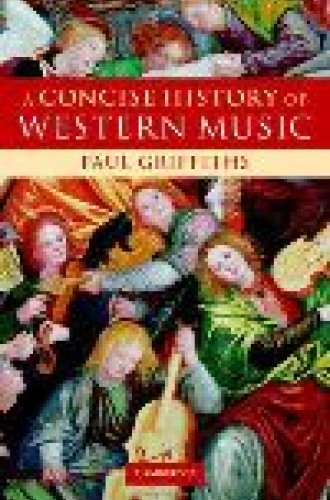A Concise History of Western Music
In his 30 years as a music critic in New York and London, Paul Griffiths has published more than 2 million words about classical music. In this book he constructs a boiled-down narrative of musical history. The writing reflects a big-city, public, secular approach to the music Griffiths has chosen to include. For an intended audience apparently made up primarily of consumers—concertgoers and record-buyers eager to learn the historical background of favorite compositions and composers—this is a useful introductory volume.
The thread that runs through the volume is Griffiths’s thesis about perceptions of time through music, from “prehistory” to 2004. Wherever it will help his chronologically organized narrative to be a grand sweep, Griffiths inserts remarks about influences on the future. For example, in describing the music of Guillaume de Machaut (c. 1300-1377), Griffiths mentions Machaut’s “distant colleagues” of six centuries later: Igor Stravinsky, Olivier Messiaen and several others who used similar compositional ideas. Griffiths thus constructs an illusion of progress, showing how musical styles and trends pressed forward through evolutionary developments—a web of interconnections formed sometimes in a straightforward manner and sometimes skipping generations.
Inevitably, this narrow theme of progress forces Griffiths to omit composers whose work doesn’t neatly fit his premise (as if the most important work before the 20th century were done by white males or within Austro-German borders). But history—musical and otherwise—does not flow in an orderly manner and in only a few directions. Griffiths’s narrative neglects musicians whose idiom was conservative—that is, musicians who put craftsmanship and a quest for simple attractiveness ahead of a push for progress. I had hoped to read some perspective about Samuel Barber, Ottorino Respighi, Michael Haydn and the lutenists, but they’re not here. Hundreds of other worthy composers are lucky to get a sentence or two each.
Where the book presents music written since 1908, it is stimulating. Griffiths gives 100 pages of excellent coverage to 20th-century music, the appreciation of which is obviously his strength. As for the time period from antiquity through the 19th century, dozens of other music-history surveys provide broader coverage, greater depth, more stylistic accuracy and sounder insights. The field is simply too large for adequate coverage in a few hundred pages.
The balance is dismaying in other ways, too. We hear almost exclusively about composers—not performers, teachers, theorists, writers, aestheticians, instrument makers, arrangers and others involved in the production of music. Nor do we hear about changes in instrument designs, playing technique, performance practices or pedagogy. Griffiths describes the people and culture around music but doesn’t get into direct musical analysis.
Furthermore, this book has the odd constraint of a text-only format, with no pictures, diagrams, musical notation or footnotes. The lack of illustrations works both ways, creating a flowing unity but also a sense of monotony. (A CD of listening examples would have been worth tens of thousands of words, but there isn’t one here.) The presentation is by necessity only a superficial skim, reducing musical shapes and emotions to mere words.
Most disappointing, Griffiths doesn’t present Western music as a thing that one might do oneself. This music can offer fun, spiritual enrichment, beauty, social connections, challenge, profit and other personal and community benefits. The self-discipline of practicing is itself a valuable life skill. By contrast, the thrust of Griffiths’s history is that music is only something to consume, relatively passively. Religious experience is slighted, too: after we pass the Renaissance and Baroque periods, there is almost nothing further about church music or the choral repertoire.
Though I am disappointed that many important strands of history could not be accommodated, Griffiths had the impossible task of serving all kinds of readers. He obviously had to make difficult choices, and he made them well, creating a plausible historical overview. I am impressed by the connections and relevant facts that the author did manage to fit into the available space. The book is enjoyable to read. If it sparks further enthusiasm and exploration of music by a casual listener, it will have served its purpose as an introduction. If it sparks that listener to read more books, take courses or work at being a musician, so much the better.





